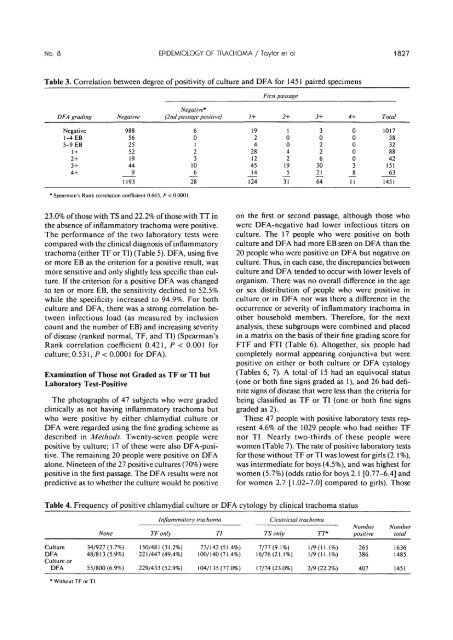The Epidemiology of Infection in Trachoma - Investigative ...
The Epidemiology of Infection in Trachoma - Investigative ...
The Epidemiology of Infection in Trachoma - Investigative ...
You also want an ePaper? Increase the reach of your titles
YUMPU automatically turns print PDFs into web optimized ePapers that Google loves.
No. 8 EPIDEMIOLOGY OF TRACHOMA / Toylor er ol 1827<br />
Table 3. Correlation between degree <strong>of</strong> positivity <strong>of</strong> culture and DFA for 1451 paired specimens<br />
First passage<br />
DFA grad<strong>in</strong>g<br />
Negative<br />
Negative*<br />
(2nd passage positive)<br />
7+<br />
2+<br />
3+<br />
4+<br />
Total<br />
Negative<br />
1-4 EB<br />
5-9 EB<br />
1 +<br />
2+<br />
3+<br />
4+<br />
988<br />
56<br />
25<br />
52<br />
19<br />
44<br />
9<br />
1193<br />
6<br />
0<br />
1<br />
2<br />
3<br />
10<br />
6<br />
28<br />
19<br />
2<br />
4<br />
28<br />
12<br />
45<br />
14<br />
124<br />
1<br />
0<br />
0<br />
4<br />
2<br />
19<br />
5<br />
31<br />
3<br />
0<br />
2<br />
2<br />
6<br />
30<br />
21<br />
64<br />
0<br />
0<br />
0<br />
0<br />
0<br />
3<br />
8<br />
11<br />
1017<br />
58<br />
32<br />
88<br />
42<br />
151<br />
63<br />
1451<br />
* Spearman's Rank correlation coefficient 0.665, P < 0.0001<br />
23.0% <strong>of</strong> those with TS and 22.2% <strong>of</strong> those with TT <strong>in</strong><br />
the absence <strong>of</strong> <strong>in</strong>flammatory trachoma were positive.<br />
<strong>The</strong> performance <strong>of</strong> the two laboratory tests were<br />
compared with the cl<strong>in</strong>ical diagnosis <strong>of</strong> <strong>in</strong>flammatory<br />
trachoma (either TF or TI) (Table 5). DFA, us<strong>in</strong>g five<br />
or more EB as the criterion for a positive result, was<br />
more sensitive and only slightly less specific than culture.<br />
If the criterion for a positive DFA was changed<br />
to ten or more EB, the sensitivity decl<strong>in</strong>ed to 52.5%<br />
while the specificity <strong>in</strong>creased to 94.9%. For both<br />
culture and DFA, there was a strong correlation between<br />
<strong>in</strong>fectious load (as measured by <strong>in</strong>clusion<br />
count and the number <strong>of</strong> EB) and <strong>in</strong>creas<strong>in</strong>g severity<br />
<strong>of</strong> disease (ranked normal, TF, and TI) (Spearman's<br />
Rank correlation coefficient 0.421, P < 0.001 for<br />
culture; 0.531, P < 0.0001 for DFA).<br />
Exam<strong>in</strong>ation <strong>of</strong> Those not Graded as TF or TI but<br />
Laboratory Test-Positive<br />
<strong>The</strong> photographs <strong>of</strong> 47 subjects who were graded<br />
cl<strong>in</strong>ically as not hav<strong>in</strong>g <strong>in</strong>flammatory trachoma but<br />
who were positive by either chlamydial culture or<br />
DFA were regarded us<strong>in</strong>g the f<strong>in</strong>e grad<strong>in</strong>g scheme as<br />
described <strong>in</strong> Methods. Twenty-seven people were<br />
positive by culture; 17 <strong>of</strong> these were also DFA-positive.<br />
<strong>The</strong> rema<strong>in</strong><strong>in</strong>g 20 people were positive on DFA<br />
alone. N<strong>in</strong>eteen <strong>of</strong> the 27 positive cultures (70%) were<br />
positive <strong>in</strong> the first passage. <strong>The</strong> DFA results were not<br />
predictive as to whether the culture would be positive<br />
on the first or second passage, although those who<br />
were DFA-negative had lower <strong>in</strong>fectious titers on<br />
culture. <strong>The</strong> 17 people who were positive on both<br />
culture and DFA had more EB seen on DFA than the<br />
20 people who were positive on DFA but negative on<br />
culture. Thus, <strong>in</strong> each case, the discrepancies between<br />
culture and DFA tended to occur with lower levels <strong>of</strong><br />
organism. <strong>The</strong>re was no overall difference <strong>in</strong> the age<br />
or sex distribution <strong>of</strong> people who were positive <strong>in</strong><br />
culture or <strong>in</strong> DFA nor was there a difference <strong>in</strong> the<br />
occurrence or severity <strong>of</strong> <strong>in</strong>flammatory trachoma <strong>in</strong><br />
other household members. <strong>The</strong>refore, for the next<br />
analysis, these subgroups were comb<strong>in</strong>ed and placed<br />
<strong>in</strong> a matrix on the basis <strong>of</strong> their f<strong>in</strong>e grad<strong>in</strong>g score for<br />
FTF and FTI (Table 6). Altogether, six people had<br />
completely normal appear<strong>in</strong>g conjunctiva but were<br />
positive on either or both culture or DFA cytology<br />
(Tables 6, 7). A total <strong>of</strong> 15 had an equivocal status<br />
(one or both f<strong>in</strong>e signs graded as 1), and 26 had def<strong>in</strong>ite<br />
signs <strong>of</strong> disease that were less than the criteria for<br />
be<strong>in</strong>g classified as TF or TI (one or both f<strong>in</strong>e signs<br />
graded as 2).<br />
<strong>The</strong>se 47 people with positive laboratory tests represent<br />
4.6% <strong>of</strong> the 1029 people who had neither TF<br />
nor TI. Nearly two-thirds <strong>of</strong> these people were<br />
women (Table 7). <strong>The</strong> rate <strong>of</strong> positive laboratory tests<br />
for those without TF or TI was lowest for girls (2.1 %),<br />
was <strong>in</strong>termediate for boys (4.5%), and was highest for<br />
women (5.7%) (odds ratio for boys 2.1 [0.77-6.4] and<br />
for women 2.7 [1.02-7.0] compared to girls). Those<br />
Table 4. Frequency <strong>of</strong> positive chlamydial culture or DFA cytology by cl<strong>in</strong>ical trachoma status<br />
None<br />
Inflammatory<br />
TF only<br />
trachoma<br />
77<br />
Cicatricial trachoma<br />
TS only<br />
TT*<br />
Number<br />
positive<br />
Number<br />
total<br />
Culture<br />
DFA<br />
Culture or<br />
DFA<br />
34/927 (3.7%)<br />
48/813(5:9%)<br />
55/800 (6.9%)<br />
150/481 (31.2%)<br />
221/447(49.4%)<br />
229/433 (52.9%)<br />
73/142(51.4%)<br />
100/140(71.4%)<br />
104/135(77.0%)<br />
7/77(9.1%)<br />
16/76(21.1%)<br />
17/74(23.0%)<br />
1/9(11.1%)<br />
1/9(11.1%)<br />
2/9 (22.2%)<br />
265<br />
386<br />
407<br />
1636<br />
1485<br />
1451<br />
• Without TF or TI.
















